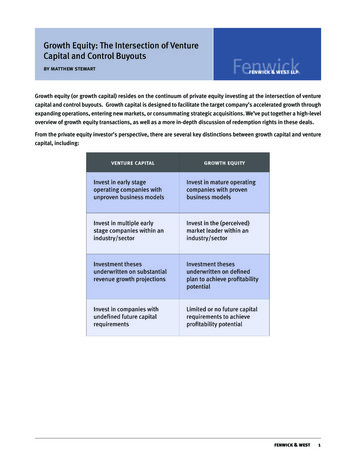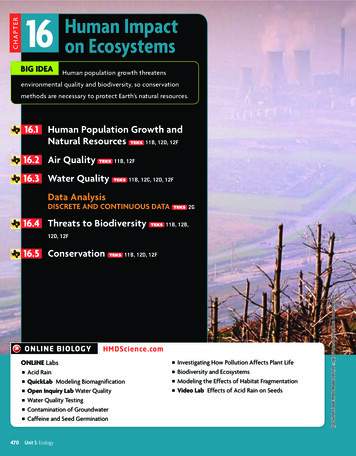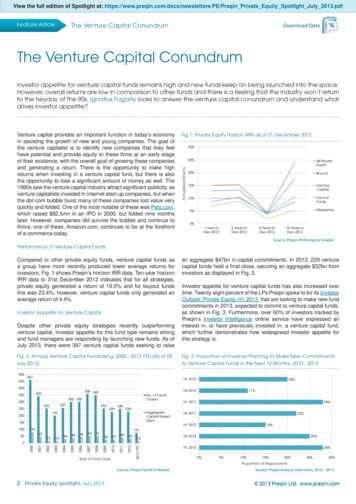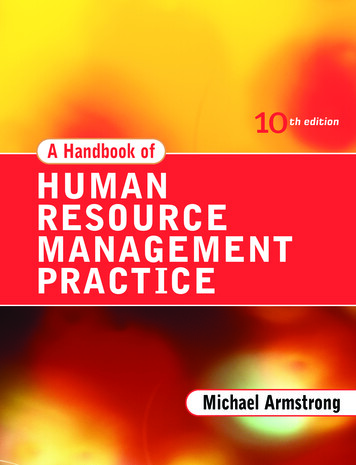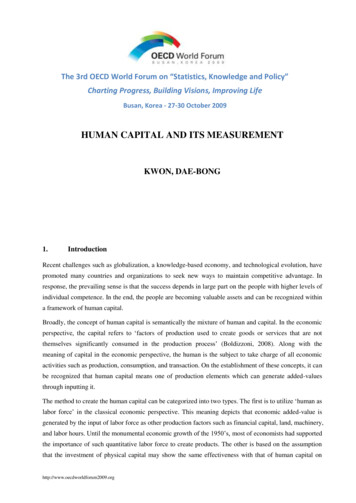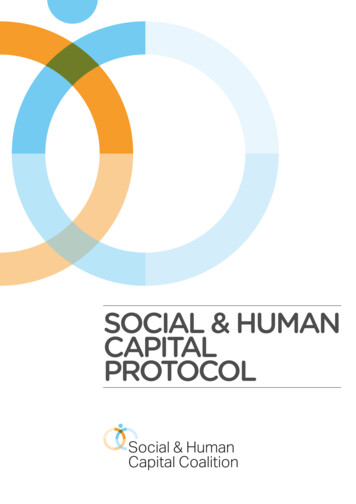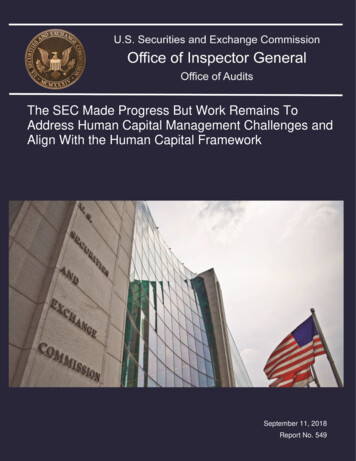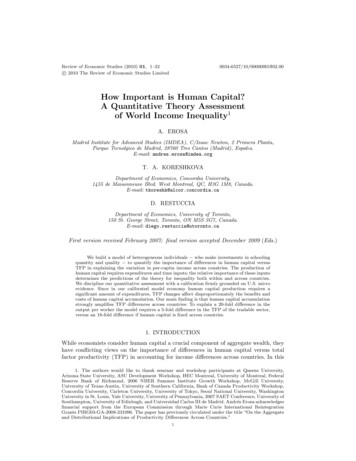
Transcription
Munich Personal RePEc ArchiveHuman Capital and Population Growthin Non-Metropolitan U.S. Counties: TheImportance of College Student MigrationWinters, John VAuburn University Montgomery1 October 2010Online at https://mpra.ub.uni-muenchen.de/25592/MPRA Paper No. 25592, posted 01 Oct 2010 19:32 UTC
Human Capital and Population Growth in Non-Metropolitan U.S.Counties: The Importance of College Student MigrationJohn V. Winters*AbstractResearchers have consistently shown that the stock of human capital in an area, measured as theshare of the adult population with a college degree, is a strong predictor of future populationgrowth. This paper examines this relationship for U.S. non-metropolitan counties and posits thatstudent migration for higher education may play an important role. Students often move to anarea for college and then stay in the area after their education is complete, causing the area’seducated population to grow. Empirical evidence suggests that student migration explains nearlyall of the greater in-migration to highly educated non-metropolitan counties. Implications fornon-metropolitan brain drain are discussed.JEL Classification: R11, R23Keywords: population growth, migration, human capital, non-metropolitan counties, college*Department of Economics, Auburn University at Montgomery, PO Box 244023, Montgomery,AL 36124-4023, Phone (334) 244-3471, E-mail jwinter3@aum.edu.
IntroductionLocal population growth has been a subject of considerable interest to both academicsand policymakers and is an important indicator of an area’s desirability. For both metropolitanand non-metropolitan areas, a growing population signals that an area is a desirable place to liveand work. Researchers have suggested that a number of characteristics have important effects onan area’s population growth by affecting its desirability to current and prospective residents.Early researchers such as Carlino and Mills (1987) recognized the importance of localemployment prospects and natural amenities. More recent research has investigated therelationship between the local human capital stock and local population growth.Overwhelmingly, these researchers have found strong and consistent evidence that the share ofadults in an area with a college degree is positively correlated with local population growth forcities (Glaeser, Scheinkman, & Shleifer, 1995; Simon, 1998), counties (Clark & Murphy, 1996;Partridge, Rickman, Ali, & Olfert, 2008a), and metropolitan areas (Glaeser & Saiz, 2004;Glaeser & Shapiro, 2003; Gottlieb & Fogarty, 2003; Simon & Nardinelli, 2002).1 Similarly,Berry and Glaeser (2005), Waldorf (2009), and Whisler, Waldorf, Mulligan, and Plane (2008)suggest that an areas ability to attract and retain a well-educated workforce depends positively onits existing level of human capital.This relationship between the share of college educated workers and local populationgrowth is thought to be due in part to the many other beneficial effects that educated workershave on their local labor markets. For one, researchers have suggested that educated workersmake other workers in the area more productive. Consistent with this reasoning, a number ofstudies have shown that wages in an area increase with the local level of human capital, evenafter controlling for a worker’s own level of human capital (e.g., Iranzo & Peri, 2009; Moretti,1
2004a; Rauch, 1993).2 This notion also receives support from the literature on the geographiclocalization of patent citations and its relationship with university research (Adams, 2002;Audretsch & Feldman, 1996; Jaffe, 1989; Jaffe, Trajtenberg, & Henderson, 1993). Otherresearchers have also suggested that educated workers improve the quality of life in the localarea by facilitating the existence of endogenous consumer amenities such as parks, theaters,museums, and tolerance of others (Florida, 2002; Shapiro, 2006).A separate explanation advanced recently by Winters (2010) is that the connectionbetween human capital and population growth is largely due to the growth of areas that arecenters of higher education.3 Areas that have major colleges and universities receiveconsiderable in-migration from students pursuing higher education. This is especially true forflagship state universities that bring in students from all over the state and from other states andcountries (Alm & Winters, 2009). Many of the students who move to an area for highereducation are likely to leave the area after their education is complete, but a significant numbermay develop location-specific human capital and stay in the area after their schooling iscomplete. The ability of centers of higher education to retain ex-students causes both populationgrowth and an increase in the average level of human capital. Winters investigates thisexplanation for metropolitan areas by separately examining the effect of human capital on themigration rates of those enrolled in higher education and those not enrolled in higher education.Winters finds that the majority of the differential in-migration to high human capitalmetropolitan areas is attributable to persons enrolled in higher education.This paper builds on the work of Winters (2010) and others by investigating theimportance of student migration in the relationship between human capital and populationgrowth for non-metropolitan counties in the U.S. Non-metropolitan areas are often different2
from metropolitan areas in important ways, and thus a separate study that focuses on nonmetropolitan areas seems warranted. In particular, non-metropolitan areas may face greaterchallenges in attracting and retaining educated workers. Young, college-educated workers mayoften be attracted to large metropolitan areas because they offer higher wages and thickermarkets for skilled labor (Chen & Rosenthal, 2008; Elvery, 2010; Plane & Jurjevich, 2009).Artz (2003) and others argue that “brain drain” is a very real problem for many non-metropolitanareas of the U.S. On the whole, non-metropolitan areas are not keeping up with metropolitanareas in the share of their populations with college degrees and this trend threatens the economicsurvival of these areas. Carr and Kefalas (2009) go even further to suggest that rural brain drainand the hollowing out of Middle America are harmful to the nation as a whole. Importantlythough, there is considerable diversity in brain drain outcomes among non-metropolitan areas. Anumber of non-metropolitan counties have actually experienced a “brain gain” and seen theircollege graduate shares increase at even faster rates than the average metropolitan county (Artz).By examining the role of student migration in non-metropolitan county population growth, thispaper offers insight into the importance of higher education institutions in attracting educatedpersons to non-metropolitan areas.The empirical results suggest that virtually all of the relationship between human capitaland non-metropolitan county in-migration between 1995 and 2000 is due to the in-migration ofstudents enrolled in higher education. Persons not enrolled in higher education are not moving tohigh human capital counties in large numbers. The results, therefore, suggest that the local levelof human capital causes non-metropolitan counties to grow because of students moving in forhigher education and then staying after their education is complete. Furthermore, when weremove “college towns” from the analysis the effect of the local human capital level on net3
migration is virtually zero. That is the growth of high human capital non-metropolitan countiesis driven by college towns. These results also suggest that non-metropolitan areas with a strongpresence of higher education institutions are likely to be much more successful at growing theirshare of college graduates than areas without good access to higher education.Theoretical FrameworkFollowing a large literature beginning with Sjaastad (1962), this paper views migration asan investment in human capital. Individuals maximize expected utility and choose to move to anew area if it gives them greater utility than their previous location and the utility difference islarge enough to compensate for the costs of moving. If moving costs are sufficiently small,individuals will move to the location that gives them the highest possible utility. Importantlythough, the attractiveness of a particular location will vary across individuals. For example,several researchers have suggested that the young and the elderly are attracted to differentlocations (e.g., Chen & Rosenthal, 2008; Clark & Hunter, 1992; Conway & Rork, 2006; Plane &Heins, 2003; Plane & Jurjevich, 2009). Young people are generally attracted to areas with highwages and a strong labor market, while the elderly often prefer areas with nice natural amenitiesbut a low cost of living. Similarly, individuals will differ in the benefit they receive from livingin an area with a high level of human capital.Following Winters (2010) this paper argues that students pursuing higher education aremore likely than non-students to move to a high human capital area, because they are oftencenters of higher education. Several college town counties rank near the top of the list of nonmetropolitan counties in the share of adults with a college degree. These include but are notlimited to counties that contain universities such as Washington State University, the University4
of Wyoming, Kansas State University, Montana State University, Mississippi State University,Oklahoma State University, and Southern Illinois University Carbondale. Consequently, personsenrolled in higher education may make up a large share of the in-migration to high human capitalcounties, because they are the ones who most benefit from moving to a college town.Many of the students who move to college towns in large numbers are likely to leave thearea once they complete their education. They will often move back to previous residences ormove on to new locations.4 However, previous literature suggests that many people who moveto an area for higher education will stay there after they are done with school (Blackwell, Cobb,& Weinberg, 2002; Groen, 2004; Groen & White, 2004; Hickman, 2009; Huffman & Quigley,2002).5 This likely occurs because students often develop location-specific human capital in thearea where they attend college (Berry & Glaeser, 2005; DaVanzo, 1983; Krupka, 2009). After afew years of college, recent in-migrants may have gained human capital that makes them moreproductive locally than elsewhere. This might include networks with professors and peers aswell as relationships with local employers through student working and internships. Individualsmay also develop location-specific human capital in consumption; they may have createdvaluable friendships and acquired a taste for local amenities (e.g., live college sports) in the areawhere they attended college.If location-specific human capital frequently motivates recent in-migrants to remain inthe area where they completed their education, areas with a considerable university presence arelikely to grow faster than those without, and student migration will play an important role in thisgrowth. Furthermore, the growth will be from highly educated individuals, and the average levelof human capital in the area is also likely to increase. Thus the growth of areas may be stronglyaffected by their ability to attract and retain individuals pursuing higher education.5
Empirical MethodsThis study examines the relationship between human capital and population growth byestimating several migration equations for non-metropolitan counties in the U.S. between 1995and 2000.6 More specifically, the following in-migration, out-migration, and net migrationequations are estimated:(1)Min βinS ΓinZ µin,µin λinWµin εin,(2)Mout βoutS ΓoutZ µout,µout λoutWµout εout,(3)Mnet βnetS ΓnetZ µnet,µnet λnetWµnet εnet,where Min is the county in-migration rate, Mout is the out-migration rate, Mnet is the net migrationrate, S is the share of the adult population with college degrees in a county, Z is a matrix of othervariables found in previous literature to affect local population growth, µin, µout, and µnet arespatially autocorrelated error terms, W is a spatial weighting matrix, λin, λout, and λnet are spatialerror coefficients, and εin, εout, and εnet are mean zero error terms. For the results presented, W isstructured as a row-standardized matrix with weights based on the inverse of their distance to agiven county and a cutoff of 100 miles; that is, nearer counties are given greater weight thanmore distant counties and counties more than 100 miles away are given zero weight. The mainresults, however, are robust to several alternative specifications of the spatial weight matrix.6
Because of the spatial error correlation, the equations are estimated using Maximum Likelihood(ML) instead of Ordinary Least Squares (OLS) (Anselin, 1988).7Because high human capital areas are often centers of higher education, βin is expected tobe positive, suggesting that a disproportionately large number of people are moving to highhuman capital counties. Similarly, if many people leave an area after completing their education,we also expect human capital to be associated with high rates of out-migration, so βout isexpected to be positive as well. However, some people will likely stay in an area aftercompleting their education causing βin to exceed βout and the local population to grow.Therefore it is expected that βnet will also be positive.The migration equations above are first estimated for the entire population to gauge theoverall effects. Migration equations are then estimated separately for persons age 16 and over bywhether they are currently enrolled in higher education. Analysis of Census 2000 County-toCounty Migration files reveals that 15 percent of all persons age 16 and over living in a differentcounty in 2000 than in 1995 were enrolled in higher education in 2000. If the relationshipbetween human capital and population growth is largely due to persons enrolled in highereducation, then the effect of human capital on the in-migration rate of those enrolled should bedisproportionately large. As a further test of the hypothesis advanced, this paper also estimatesseparate migration equations for five year age groups. The expectation is that persons in theirpeak college-going years may represent a disproportionately large share of the relationshipbetween the local human capital level and in-migration.Data7
The migration data in this paper come from the Census 2000 County-to-CountyMigration files. This dataset includes only internal migrants; international in-migrants and outmigrants are not included. A person is considered a migrant if they lived in a different county in2000 than they did in 1995. While defining a person’s place of residence is straightforward formost people, it is a bit more complicated for some young people away at college. In a sense,some such students have two residences: the place where they reside while attending school andthe place where they reside in between school sessions, often being their parents’ residence. TheCensus questionnaire instructed respondents that students away at college are to be counted asresidents of the places where they attend college and not their parents’ residences. Unfortunatelythough, there could still be some misreporting of residences, especially prior residences ofpersons who were enrolled in college five years prior to the census. If so, the effects of thecollege share on out-migration may be understated and the effects of the college share on netmigration may be overstated. To partially address this concern, we also briefly look at the effectof the share of adults with a college degree on population growth.Gross in-migration to an area is computed as the sum of all persons in a county who livedin another county in the U.S. five years prior. Gross out-migration is the sum of all persons wholived in a given county in 1995, but lived in a different county in the U.S. in 2000. Net migrationis computed as gross in-migration minus gross out-migration. Gross in-migration rates for nonmetropolitan counties are computed by dividing gross in-migration by the estimated populationof the county in 1995. Gross out-migration rates and net migration rates are computed similarly.When the migration rates are computed separately by enrollment status or by age, the totalpopulation of the county continues to be used as the population base. This is done to allow foreasier interpretation of each groups’ contribution to the overall migration rate.8
Data for the explanatory variables in the regressions come from several sources. Timevarying explanatory variables are measured as of 1990, so that they are not affected by migrationduring the period under consideration. The share of the adult population in a county with acollege degree comes from the USA Counties database. Several additional explanatory variablesare also computed from USA Counties data. These include the county population, per capitaincome, and the share of employment in manufacturing. The quantity and quality of naturalamenities is expected to affect non-metropolitan migration (Gottlieb & Joseph, 2006;McGranahan, 1999; McGranahan, Wojan, & Lambert, 2010; Rappaport, 2007), and data onseveral natural amenities are obtained from the USDA Economic Research Service (ERS).These include the mean January temperature, mean January sun hours, mean July temperature,mean July relative humidity, the percent of the county area that is covered by water, and atopography score that ranges from 1 to 24 with higher values indicating a more mountainoustopography. Partridge et al. (2008a, b, c) suggest that population growth for non-metropolitanareas may depend on proximity to urban areas, in part because close proximity makes rural-tourban commuting a more viable option (Partridge, Ali, & Olfert, 2010). Therefore, this paperalso includes as explanatory variables the population of the nearest metropolitan area, thedistance to the nearest metropolitan area, the distance to the nearest metropolitan area with apopulation of at least 250,000, the distance to the nearest metropolitan area with a population ofat least 500,000, and the distance to the nearest metropolitan area with a population of at least1,500,000. Finally, indicator variables for the Midwest, South, and West regions are alsoincluded.(Table 1 about here)9
Summary statistics for the main variables used in this study are presented in Table 1. Thesample includes 2,004 non-metropolitan counties in the contiguous United States. Severalvariables have been rescaled to aid the presentation of results. The reported summary statisticsreflect the scaling used in the regressions to follow. The mean in-migration and out-migrationrates for the total population are both about 0.18 indicating that on average about 18 percent of anon-metropolitan county’s population lived in a different county in 2000 than they did in 1995.The summary statistics also indicate that for the average county, migration of those not enrolledis a considerably larger portion of overall migration than migration of those who are enrolled.8However, the relative importance of college students in overall migration varies considerablyacross counties.Empirical ResultsThe migration equations are first estimated for the entire population. These results arepresented in Table 2. The first column presents the results for the in-migration rate, the secondcolumn presents the results for the out-migration rate, and the third column presents the resultsfor the net migration rate. As expected, the share of adults in the county with a college degreehas a strong positive correlation with the in-migration rate. In other words, more people aremoving to highly educated places than less educated places. The coefficient estimate of 0.571suggests that increasing the college share by 0.1 increases the in-migration rate by .057. This is aconsiderable effect. According to the results in the second column, the local human capital levelis positively correlated with the out-migration rate as well with a coefficient of 0.436. On netthough, the local human capital level brings in more people than it pushes out, and the collegeeducated share has a strong positive correlation with the net migration rate with a coefficient10
estimate of 0.123. This result is consistent with findings from previous literature that a moreeducated populace causes an area’s population to grow.(Table 2 about here)As discussed above, there may be problems with misreporting of previous residence inthe data, especially for persons who were attending college five years prior to the census. If so,the effects of the college share on out-migration may be understated and the effects of the collegeshare on net migration may be overstated. We partially address this concern by briefly lookingat the effect of the share of adults with a college degree on actual population growth (results notshown). When we regress county population growth between 1990 and 2000 on the explanatoryvariables, we get a coefficient of 0.300 that is statistically significant at the 1 percent level.Cutting the effect in half to account for the longer time period gives a coefficient of 0.150, whichis a little more than the coefficient for net migration between 1995 and 2000. The differencemight be partially attributable to international in-migration, differences in fertility and mortality,and asymmetry between the first and second halves of the decade. Given all of theseconsiderations, the results for population growth are quite similar to the results for net migrationand reduce concerns that measurement error causes major problems for the net migrationregressions.The results in Table 2 also suggest that many of the other variables have important effectson migration as well. However, we will later see that these variables often have differing effectson student and non-student migrants. Because the effects of these variables are a secondaryinterest of this paper, we will hold off on discussing the results for these variables until the nextsubsection when we estimate separate migration equations for persons enrolled in highereducation and person not enrolled.11
Migration by Enrollment in Higher EducationThe results in Table 2 tell us that the share of adults in an area who are college educatedis positively correlated with future population growth. However, Table 2 does not tell us muchabout the role of student migration in the relationship between the local level of human capitaland population growth. More specifically, this paper is interested in the extent to which thepositive relationship between human capital and non-metropolitan population growth isattributable to students moving to an area for higher education and then staying in the area aftertheir education is complete. To investigate this, the migration equations are next estimatedseparately for persons enrolled in higher education and persons not enrolled in higher education.For these equations, the migration rates include only persons age 16 and over, but the results areunaffected by including persons under age 16. The results are presented in Table 3.(Table 3 about here)Looking first at the in-migration equations, the positive relationship between the share ofadults with a college degree and in-migration rates appears to be entirely due to persons enrolledin higher education. The coefficient for those enrolled is 0.574 and highly statisticallysignificant. The coefficient for those not enrolled, however, is virtually zero (0.001). Theseresults suggest that students moving for higher education account for virtually all of the greaterin-migration to highly educated non-metropolitan counties. Persons not enrolled in highereducation are not moving to these areas in large numbers.The results in Table 2 also suggested that out-migration rates are positively correlatedwith the local human capital level. If the relationship between in-migration and human capital isdue to student in-migrants, then the positive relationship between human capital and outmigration rates is likely due in part to persons leaving after completing their education. The12
separate out-migration equations by enrollment in Table 3 shed light on this as well. The humancapital stock is positively correlated with the out-migration of both those enrolled in highereducation and those not enrolled. The majority of the effect, however, is due to persons notenrolled. This is consistent with the hypothesis that individuals move to high human capitalareas for higher education, but often leave after completing their education.Turning to the net migration results, the share of adults with a college degree is positivelyand significantly correlated with the net migration rate for those enrolled with a coefficientestimate of 0.488. For those not enrolled in higher education, the human capital stock isnegatively and significantly correlated with net migration with a coefficient estimate of -0.334.Thus, highly educated areas are on net gaining people enrolled in higher education and losingpeople not enrolled in higher education. This is again consistent with the hypothesis that peoplemove to highly educated areas for education but often leave once their formal education is done.Importantly though, the net migration coefficient for those enrolled is larger in absolute valuethan the net migration coefficient for those not enrolled. This suggests that some of the peoplewho move for higher education end up staying in the area after their educations are complete.This causes highly educated areas to experience faster population growth than their less educatedcounterparts.The results in Table 2 suggested that many of the other variables have important effectson migration. The results in Table 3 suggest that these variables often have differing effects onthe migration of those enrolled in higher education and those not enrolled. Focusing on the netmigrations equations for brevity, the results suggest that the local population increases the netmigration of students but decreases the net migration of non-students. Per capita income has theopposite effect - it decreases the net migration of students but increases the net migration of non-13
students. The manufacturing share has a positive but insignificant coefficient for the netmigration of those enrolled but a negative and significant effect on the net migration of those notenrolled. January temperature and January sun have positive and significant effects on the netmigration of those not enrolled, but for the net migration rate of those enrolled Januarytemperature has an insignificant effect and January sun has a significantly negative effect. Julytemperature significantly reduces the net migration of those not enrolled, but significantlyincreases the net migration of those enrolled. July humidity is insignificant for both.Topography and the percent of the area covered by water have significantly positive effects onthe net migration of those not enrolled, but negative coefficients for the net migration of thoseenrolled, though the effect for topography is not significant. These results suggest that personsnot enrolled in higher education are drawn to areas with nice natural amenities, but personspursuing higher education are generally not. The distance to the nearest metro area has anegative and significant effect on the net migration of both those enrolled and those not enrolled,supporting the findings of Partridge et al. (2008a, b, c). The distance to the nearest metro with apopulation of at least 1.5 million also has a significantly negative effect on the net migration ofpersons enrolled in higher education. This suggests that proximity to a large metropolitan area ismore important for student migrants than non-student migrants. The West region dummy issignificantly positive for the net migration of persons not enrolled, the South dummy issignificantly positive for both, and the Midwest dummy is significantly positive for thoseenrolled. Finally, the spatial error coefficient is significant in all of the equations confirming thatstandard errors are spatially correlated. Consequently, methods that do not account for spatialerror correlation such as OLS are likely to produce inconsistent standard errors and potentiallyincorrect inferences. The magnitude and significance of the spatial error term also suggest that14
there are important unobserved regional factors that affect nearby counties in similar ways.Thus, policymakers for non-metropolitan counties might often be well served by working withother nearby counties to make their entire regions more desirable to potential migrants.Migration by Age GroupEvidence in the previous section suggests that the relationship between the local humancapital level and population growth is primarily due to persons pursuing higher education. If thisis true, we also might expect the age distribution of persons moving to high human capital areasto be skewed towards persons in their primary college-going years. Similarly, we might expectthe age distribution of persons leaving high human capital areas to be skewed towards agegroups who are likely to have recently completed higher education or dropped out of school.This paper, therefore, next examines the effect of human capital on migration by five year agegroups. Table 4 presents the results for the effect of the share of adults with a college degree onin-migration, out-migration, and net migration rates between 1995 and 2000. Though the resultsare not reported, the regressions in Table 4 also include the additional explanatory variablesincluded previously. The full results are available upon request. The coefficients in Table 4 are
Auburn University Montgomery 1 October 2010 Online at https://mpra.ub.uni-muenchen.de/25592/ MPRA Paper No. 25592, posted 01 Oct 2010 19:32 UTC. Human Capital and Population Growth in Non-Metropolitan U.S. . rate, S is the share of the adult population with college degrees in a county, Z is a matrix of other .

